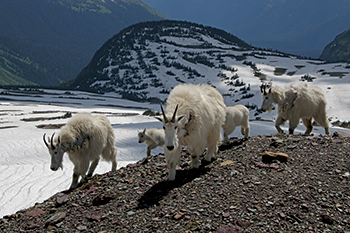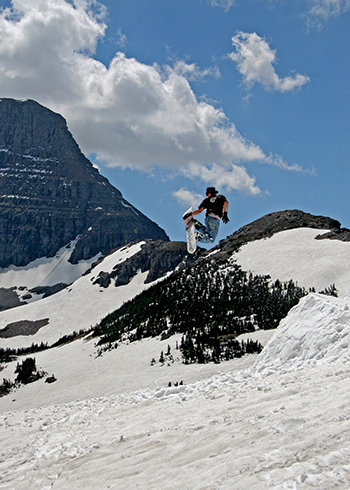Editor’s Note: This is one of the stories you will find in the spring edition of Flathead Living magazine. Pick up a free copy on newsstands throughout the valley.
Twirls of golden fog rise from the lake, dancing to the syncopated song of mismatched bird voices. The paddleboards and kayaks glisten with dew, next to fishing poles cradled in a crook of an old cottonwood tree. We know that a perfect summer day on Swan Lake is in store – sunny and 70s amidst a world bursting into lime green set against intense blue skies and mountains still capped with snow. But we turn away from the lake and head to the car.
It is nearly July and we are going skiing. While many drag themselves through gray winter days counting time until golf, boating, swimming, or just loafing in the sun, our family hangs on to every last breath of winter.
The opening of Logan Pass at the end of June or early July heralds the beginning of summer in the Flathead Valley as the Going-to-the-Sun Road begins to pump thousands of visitors through the heart of Glacier National Park each day, but it also offers an opportunity to revisit winter’s snow. Opening day attracts locals as well as out-of-area visitors to the magical experience of passing through three seasons on the 32-mile stretch of the Sun Road from West Glacier to Logan Pass. It is almost like turning back the clock as cars leave the lush, summery conditions along Lake McDonald and wind upward past aspens with nubby buds to shrubs that are swallowed by fields of snow.
Steep snowbanks frame the approach to the parking lot where cars pull in and visitors spill out. Some pause for just a brief moment, long enough to suck in the high-altitude air and spectacular views. Others, like us, are here to play in the snow. Kids clamber up snowbanks and scoop up snow for the inevitable snowball launch. The excitement and exotic quality of snow in July creates a contagious party atmosphere.
The morning air is colder at 6,640 feet along with the refrigerator effect of snow, but it won’t be long until we are soaked by high summer sun on one of the longest days of the year.
We join the snowy pilgrimage that climbs upwards in anticipation of the reward of a single run. The gentle slope of the Hanging Gardens bench provides a friendly snow playground before rapidly rising to sheer rocky faces.
Snowboarders, turtle-like with boards slung on their backs, kick in boot steps to reach a vertical section of slope that allows for an airy launch. Another group arrives to skin up with skis, which gives them the ability to head straight up steeper sections of slopes. A young mother carries a smiling baby in a backpack as she skis up a gentle grade for a mellow run, and a father and son in tennis shoes are able to climb steadily up a ridge along bare patches of rock and then through a couple inches of loose “corn” snow, formed with the spring melt-freeze cycle at the surface.
We head away from the hub of activity towards Mount Oberlin past turquoise ice ponds and snowmelt spilling over rocky faces where Logan Creek slices through six-foot walls of snow. It becomes mazelike as we avoid sections where spring has prevailed and glacier lilies lift their sunny heads amid grass carpets and snow patches.
 |
|
Mountain goats walk up a rocky ridge beneath Clements Mountain in Glacier National Park. Kay Bjork | Flathead Living |
Not too many years ago, before Logan Pass’s exploding popularity as a winter playground, we were often alone except for the marmots, goats, and sheep we spotted on our journey. One year we had the thrill of seeing a wolverine, his snow snuffling and shuffling punctuated by hops as he searched for lunch. Another memorable event was the appearance of a herd of goats and their steely-eyed gazes as they marched over a rise, unaffected by our presence.
Today we see more human animals than wild ones – the stream of walkers on the Hidden Lake Trail become ant-like as we climb higher above the visitor center. We pass under Clements Mountain and past the Hidden Lake trail where many of today’s visitors wear shorts and T-shirts, but in the “wait-a-minute” mountain climate could have easily been in boots and parkas.
We continue traversing in an easterly direction until we hit a sunny bench where we stop for lunch and to watch the show around us. Boarders have built a jump and take turns spotting each other and lobbing over the hard-packed drop. Spectators join the ecstatic hooting and hollering of the boarders as their landings spatter like fireworks in the soft snow.
There is something quite delicious about baking in the sun while surrounded by snow, so we lollygag a little longer before we pack up and step back into our skis to continue in the direction of Reynolds Mountain. We spot two skiers on a steep snowfield and watch as they leave turns that become shiny ribbons flowing down the mountain.
A goat and its kid graze in a soggy, grassy patch where sunshine and summer have triumphed in spite of deep snowpack in shady places or snowdrifts. The snow gets heavy and sloggy as the day heats up, so we head back to the parking lot taking long traverses and gentle turns on our cross-country skis.
The pace has picked up at the parking lot as cars do laps in search of spots. We load the car and surrender our spot to a group that is happy to see us leave so they can have their turn at winter in summer.
Less than two hours later we arrive home. The sun is still perched above Crane Mountain so we plop the paddleboards in the lake next to the dock and step out to catch a summer sunset. I follow the silver stream left on a glassy lake by my husband’s board and pause to look up at the snowfields that remain on the Swan Range, thinking, “It seems a world away.”
Other high spots
Marias Pass along U.S. Highway 2 and next to the southeastern border of Glacier National Park also provides late-season skiing. You can normally ski into April, depending on the generosity of old man winter. Once you reach the 5,213-foot pass, you will reach a rest area marked by an obelisk and statue of John F. Stevens, the Great Northern Railway engineer who charted the pass. Here you have two great options – the six-mile Autumn Creek Trail in Glacier Park on the west side of the highway or the vast white playground of the Flattop Mountain to the east.
The Autumn Creek Trail is located across the highway from the rest area. You have the option of a one-way ski or snowshoe outing if you park a second car at the pull-out at mile marker 193.8 on Highway 2. If you don’t want to involve two cars, a good option is to ski three miles to a high point before the trail starts to lose elevation and return on the same route. You can also explore the Three Bear Lakes area at the beginning of the trail, which offers a flat, open area.
 |
|
A snowboarder launches off a jump near Logan Pass. Kay Bjork | Flathead Living |
To reach Autumn Creek Trail you cross the highway from the rest area and then cross the railroad tracks to enter the park where orange markers denote the trail. Turn left at the junction to get on the Autumn Creek trail. This trail is on a gentle grade, which leads to an open area that crosses the bottom of avalanche chutes with great views of Elk Mountain. Advice from the Glacier National Park website: “If you get off trail, or have to detour past areas blown free of snow, ski to the obvious drainage of Autumn Creek to the west. Here the route follows the right side of the creek. From the start of the creek drainage there are some steep hills and creek crossings, which merit caution, especially in icy conditions.”
To the southeast of Marias Pass is a great winter playground along the unplowed Pike Creek Road. At the parking lot head through the trees until you cross the pipeline right-of-way, which will lead to Pike Creek Road. You can take the road or wander into the old burn amidst the eerily beautiful snags left by the Skyland Fire of 2006, which opened up the area to great views (and great skiing.) The road ends near the Continental Divide, offering spectacular panoramic views marked by dramatic snowdrifts and cornices, which demand caution because of their association with avalanches and unstable conditions. Flattop Mountain, at 6,549 feet, is about a 1,200 -foot rise from Marias Pass and is popular with experienced and advanced level skiers.
Know the snow
With snow fun also comes risks inherent to the force and unpredictability of the natural world. Protect yourself as well as the environment around you by being informed and taking precautions.
Conditions can be very windy at mountain passes, so pack extra layers and be prepared for rapid shifts in the weather.
Denise Germann, Glacier National Park spokesperson, stresses, “Visitors should take into account their skiing and fitness ability when planning a trip. Many times we overestimate our abilities and this can make a challenging and unpleasant adventure. The park offers a variety of experiences for all abilities and ages.”
You can find Flathead Avalanche Center snow conditions until the beginning of April at www.flatheadavalanche.org, and you can also get tips from the GNP website and at visitor centers.
Tips and guidelines from the Glacier National Park website:
As winter snows start to melt, emerging vegetation is revealed. Please stay off these fragile areas. In spring, warming conditions greatly increase avalanche activity. Cross-park trips contain extreme avalanche and terrain hazards and should be attempted only by experienced and well-equipped parties. A permit is required for backcountry camping.
Visitors are encouraged to visit the park website, www.nps.gov, or call before coming to confirm access. In the spring, before the road is open to motorized use, many of the trails are closed due to snow conditions.
The Flathead Avalanche Center usually stops issuing advisories the first part of April, so generally no current avalanche forecast is available. Depending on conditions and weather, there is a strong possibility that avalanches will hit the road and general area. Avalanche training, a beacon, shovel, and probe for everyone, is highly recommended. Solo travel is not advised. Ability and equipment to travel in steep, icy and snow-covered terrain is also recommended. Visitors need to be prepared!